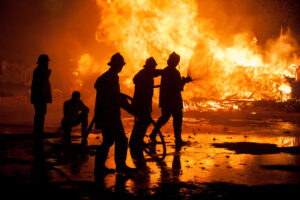On December 6, the U.S. Chemical Safety and Hazard Investigation Board (CSB) released its final report on the deadly explosions and fires at the Didion Milling, Inc., dry corn milling facility in Cambria, Wisconsin.
The May 2017 explosion fatally injured five employees and seriously injured another 14. The incident destroyed the facility, resulting in over $15 million in property damage, according to the board.
CSB investigators determined that the cause of the dust explosions and collapsed buildings was the ignition of combustible corn dust inside processing equipment, leading to multiple explosions. Didion didn’t recognize the hazards posed by combustible dust throughout the milling process, according to the board. Because of Didion’s lack of hazard recognition, the company didn’t understand or address the combustible dust hazards.
During normal mill facility operations on the night of May 31, 2017, employees smelled smoke in parts of the mill, according to the board’s report. They investigated the source of the smoke and determined that it likely was located on the first floor of one of the buildings.
While investigating milling process equipment, several employees heard an explosion and saw fire coming from piping on the rotary gap mill equipment discharge. The employees began to evacuate and attempted to notify other employees of the emergency using their radios, but conflicting radio traffic caused confusion, CSB investigators found.
A fire spread through the processing equipment via interconnected dust collection systems, resulting in explosions in some of the dust collection equipment, according to the report. Secondary explosions occurred throughout the facility. The employees who weren’t within the immediate vicinity of the observed fire were unaware of the emergency and the need to evacuate before the explosions.
“Combustible dust explosions and fires can be deadly and incredibly destructive,” Steve Owens, the CSB’s chairperson, said in a board statement. “The terrible tragedy at Didion was made even worse due to the lack of important safeguards in the design of the mill equipment and the lack of engineering controls at the facility that could have reduced the potential for serious fires and explosions.”
The CSB’s report also determined there are insufficient safety regulations for combustible dust operations. While the Occupational Safety and Health Administration (OSHA) regulates some aspects of combustible dust hazards, it doesn’t have an overarching standard to manage the hazards presented by combustible dust. The board recommended that OSHA develop a federal standard for industries that handle combustible dust, as well as increase follow-up inspections when combustible dust hazards have been identified at facilities.
The CSB has a dozen open recommendations for OSHA.
CSB issues report on fatal vapor explosion and fire
The CSB also recently released its final report on a flammable vapor explosion and fire at the Yenkin-Majestic facility in Columbus, Ohio, on April 8, 2021. One employee died during the incident, and eight other workers were injured.
The explosion and fire occurred when a mixture of flammable naphtha solvent vapors and resin liquid escaped through the seal of a closed manway of an operating kettle, creating a flammable vapor cloud that quickly spread throughout the facility. The flammable vapor cloud found an ignition source, causing an explosion and a large fire that burned for roughly 11 hours.
Safety issues identified in the report include:
- Mechanical integrity of low-pressure vessels: Yenkin-Majestic didn’t adequately ensure the mechanical integrity of a new 20-inch manway that was installed on a process vessel approximately 3 months before the incident.
- Safeguard selection and the hierarchy of controls: The hierarchy of controls is a risk management principle based on ranking hazard controls from most effective to least effective.
- Emergency preparedness: Yenkin-Majestic didn’t have adequate safeguards to minimize the consequences of the incident.
The CSB had recommendations for Yenkin-Majestic, the coatings industry, the American Petroleum Institute (API), and the American Society of Mechanical Engineers (ASME).
“The CSB calls on operating facilities to examine the three safety issues identified in the report and apply the report’s key lessons to their own facilities,” Melike Yersiz, the investigator in charge, said in a statement.

